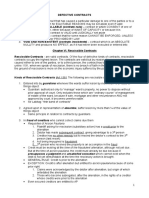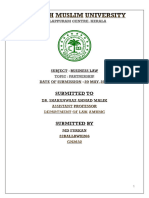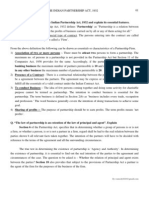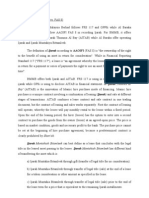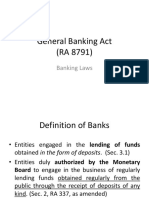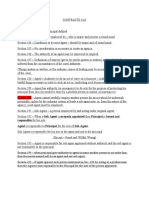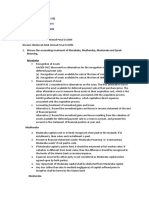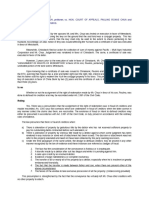Part
Part
Uploaded by
Vanshika GuptaCopyright:
Available Formats
Part
Part
Uploaded by
Vanshika GuptaCopyright
Available Formats
Share this document
Did you find this document useful?
Is this content inappropriate?
Copyright:
Available Formats
Part
Part
Uploaded by
Vanshika GuptaCopyright:
Available Formats
PARTNERSHIP ACT, 1932
Laws relating to partnership was contained in Chapter XI (Section 239 – 266) of Indian
Contract Act 1872. It was not complete in three sense and hence a new legislation was
enacted:
1)
2)
3)
Partnership Act, 1932 is an act to define and amend the law relating to Partnership. It is based
on English Partnership Act 1890.
Chapters in Partnership Act
DEFINITION
Section 2 (a) an "act of a firm" means any act or omission by all the partners, or by any partner
or agent of the firm which gives rise to a right enforceable by or against the firm;
Section 2 (b) business
Section 2 (d) "third party" used in relation to a firm or to a partner therein means any person
who is not a partner in the firm; and
Section 3 - The unrepealed provisions of the Indian Contract Act, 1872, save in so far as they
are inconsistent with the express provisions of this Act, shall continue to apply to firms.
DEFINITION OF "PARTNERSHIP", "PARTNER", "FIRM"
Story – Partnership is usually defined to be a voluntary contract between two or more
competent persons to place their money effects labour and skill, or some or all of them, in
lawful commerce or business, with the understanding that there shall be a communion of the
profits thereof between them.
This definition seems superfluous because it is not essential that every partner shall contribute
labour, skill or money, but he may lend his name only.
English Partnership Act 1890 – Partnership is the relation which subsist between persons
carrying on business in common with a view of profit.
Pollock – Partnership is the relation which subsist between persons who have agreed to share
the profits of a business carried on by all or any of them on behalf of all of them.
Section 4 - "Partnership" is the relation between persons who have agreed to share the profits
of a business carried on by all or any of them acting for all.
Persons who have entered into partnership with one another are called individually, "partners"
and collectively "a firm", and the name under which their business is carried on is called the
"firm-name".
DIFFERENCE BETWEEN COMPANY/ LLP/ PARTNERSHIP
ESSENTIALS OF PARTNERSHIP
(Nature and Characteristics of Partnership)
1) Two or more persons – may be natural or artificial persons. But partnership firm not being
an artificial person, may not be a partner in another firm.
Partnership firm is not a legal person, thus can’t enter into any other partnership firm.
Mahavir Cold Storage v. CIT (1991 – SC) – partnership firm is not a legal person. It
is a collective name for the individual members of the partnership. Firm cannot be a
partner of another firm through its partners can be in their individual capacity. A firm
is liable to be separately assessed to tax as well as all its partners in their capacity as
individuals if they have taxable income.
A partnership firm was started with its head office in Calcutta and a branch office at
Purnea. The branch office in Purnea carried on the business in the name of Shri Mahabir
Cold Storage. The partners had taken loan from Periwal & Co. for erection of cold
storage and for its running capital. Later the company was taken as a partner for better
management and financial assistance. Priyachand and Hanumanmal, who were 50%-
50% partners in the old firm, each had 25% and Periwal & Co. had the remaining 50%
shares in the profits of the newly constituted partnership M/s Mahabir Cold Storage at
Purnea. The new partnership also obtained separate registration under Income Tax Act.
In the assessment year 1959-60, M/s Priyachand Hanumanmal installed machinery in
Shri Mahabir Cold Storage. The plant and machinery were wholly used for the purposes
of cold storage business carried on by the original firm M/s Priyachand Hanumanmal
and also by the appellant. The newly constituted firm claimed development rebate on
this.
The Supreme Court held that to claim rebate under development fund, there must exist
unity in ownership and it must be used the business. Under Partnership Act, the
partnership firm registered thereunder is neither a person nor a legal entity. It is merely
a collective name for the individual members of the partnership. A firm as such cannot
be a partner in another firm in their individual capacity.
Hence, the appellant was not entitle to tax rebate.
Dulichand v. CIT (1956 – SC) –
It is not essential that all the partners are involve in the business. One partner may carry on the
business on behalf of other partners.
2) There must be an agreement as defined u/s 2 (e) valid u/s 10 of Indian Contract Act.
Agreement may be either express or implied.
Section 5 - The relation of partnership arises from contract and not from status; and, in
particular, the members of a HUF carrying on a family business as such, or a Burmese Buddhist
husband and wife carrying on business as such are not partners in such business.
A HUF is not a legal person; hence it cannot enter into a partnership firm as partner.
Chandrakant Manilal Shah v. CIT – a coparcener can enter into a partnership with Karta of
HUF contributing only his labour and skill.
Rashiklal and Co. v. Commissioner of Income Tax, Orissa (1998 SC)
Section 10 of Indian Contract Act - What agreements are contracts - All agreements are
contracts if they are made by the free consent of parties competent to contract, for a lawful
consideration and with a lawful object, and are not hereby expressly declared to be void.
Section 2 (e) of Indian Contract Act defines an agreement as "every promise and every set of
promises, forming the consideration for each other is an agreement."
3) Carrying on business – if there is no carrying on business there is no partnership. For
instance, if in the family setup interest is coming on FD, it is not carrying on business.
Section 2 (b) "business" includes every trade, occupation and profession;
A society for religious or charitable or social purposes is not partnership.
4) Profit and Loss sharing – Lindley on partnership 14th edition, p.13, stated that “the term
partnership and partner are evidently derived from “to part” in the sense to share the profits
amongst the partner.
Grace v. Smith (1775)– mere carrying of business is not enough.
Cox v. Hickman (1860, House of Lords) – no one is partner unless have right of profit sharing.
But whether that relation does or does not exist must depend on real intention and agreement
of partnership. There was no mutual agency in this case, hence the court held that no partnership
is there.
Explanation II of Section 6 provides receipt of profit does not itself makes him a partner.
Profit sharing by non- partner – lender of money, servant or agent, widow or child of
deceased partner, seller of the good will.
Although there is no bar that child and widow of deceased may not be partner is the firm. But
for that purpose, a fresh agreement is required. Unlike the company the legal representative
may not be inducted in the partnership.
Ross (Plaintiff) v. Parkyns (1875) - mere sharing of profits is not sufficient to constitute
partnership. The same was held in Abdul Latiff (Plaintiff) v. Gopeshwar (1933).
In Ross (Plaintiff) case Sir Thomas Parkyns entered into an agreement with Ross to appoint
Ross as his agent to look after the business. Ross was to apply the whole or such part of his
time and attention to the business as may be required for conducting the business. He was to
be paid by Sir Thomas Parkyns a fixed salary. Ross was to receive non-fifth of the share of the
profits and not to share losses. There was no a word about partnership in the agreement.
The court stated that to determine whether a certain agreement is an agreement for hiring or an
agreement for partnership, one must look at whole of the agreement in order to ascertain its
meaning. It is now settled by the cases of Cox v. Hickman, Bullen v. Sharp, that although a
right to profit is a strong test of partnership, and there may be cases where upon a simple
partnership in profits, there is presumption, not of law, but of fact that there is a partnership.
Yet whether the relation of partnership does or does not exist must depend upon the whole
contract between the parties and that circumstance is not conclusive.
In Ross (Plaintiff) case Salary is usually paid to an employee. It is not the sum paid to a working
partner. There was no mutual agency between them. Hence, Parkyns was the owner of the
business, and Ross was his agent. The contract was not a partnership at all but a contract for
hiring and service.
5) Mutual Agency – According to section 4, “…business must be carried on by all or any of
them acting for all.” They are in the position of both principle and agent, i.e., every partner
become mutual agents. In Section 18[1], the "partner is a representative of the company for the
company." They operate as agents as well as directors and have the unrestricted ability to bind.
This principle of mutual agency is most important and crucial factor in determining the true
relationship between persons carrying on any business common between then. It is conclusive
test of partnership.
Cox v. Hickman
Mutual agency is the partnership's legal relationship, with each member having
authority to conclude commercial contracts with the partner. This means that every
partner in the partnership is the agent in the company and authority for taking business
choices committing or binding, as a whole, to an agreement between itself and a third
party or organization.
Only partners operating in the usual scope of business activities and transactions have
mutual agency. A retail clothing partner with an agency, for example, would not be
allowed to contract other partners to buy an investment property since it would not be
in the usual company operation. On the other side, one of the retail partners might buy
products from a supplier and demand partnership payment for the products. This
transaction is part of the company's usual activity.
Facts - Under the name of B Smith & Son, Benjamin Smith and J T Smith were active
as iron and maize tradespeople. They owed the creditors a lot of money and there was
a meeting, including Cox and Wheatcroft. More than six-sevenths of the number and
value of the debtors performed a deed of arrangement. The trusts have been listed and
the rental period is 21 years. The company was to operate under the name "The Stanton
Iron Company." The deed also contains a clause preventing the Smiths from
prosecuting the current debts. After six weeks after which no trustee was appointed,
Cox had never functioned as trustee.
Hickman produced 3 bills of exchange that were accepted but not honoured by the firm.
The products were supplied for the business.
Whether the merchants who were essentially the creditors of the company are in
partnership?
Contentions of the case
The Wheatcroft argued- Cox was never a trustee and Wheatcrofte had resigned.
Smiths owned partnership was never altered. No individual becomes a partner in a
qualifying benefit from trade. There is no collaboration here until the gains are taken.
Cox's lawyer argued- Defendant’s name was not there on bills. He never allowed to
have his name on bill.
Hickman's lawyer argued- A partnership arrangement was concluded to carry out
operations for the benefit of creditors. Planed creditors may partake in the company's
earnings and become partners in the company. Any partner may bind everyone other
by accepting the invoices in the ordinary business process
Reasoning - Sharing of profits is a vital and not conclusive criterion of all the
fundamental elements of a partnership. Persons who share the profits of business did
not incur the liabilities of partners as the business was carried on by them not as an
agent of each other’s. Mutual agency is the real test for establishing partnerships. If one
partner can bind the other partners and the company by its acts and is, in turn, linked
with other partners' activities, a partnership may only be stated.
Decision – Hence, there was no partnership in this case, as mutual agency was
lacking. This is just a contract between creditors and Smiths for the repayment of
current and future earnings by the creditors. This link between the creditors and debtors
is not sufficient for the principle to have a connection with the agency. The Trustees
are responsible since they are contract agents, yet the trustees' creditors are not the
directors.
Lord Cranworth argued that profit participation is not a crucial partner test. The real
test is whether the partners are 'mutual agencies.' "A partner's responsibility for his co-
partners conduct is indeed a principal's responsibility for his agent's activities. If two or
more individuals are involved in an ordinary business, they each have an implicit
authority from another person to bind them all through contracts entered into in the
course of business. Each trading partner is his co-agent; partner's everyone is
consequently accountable for the other's regular commercial contract."
Section 6 – Mode of Determining Existence of Partnership. In determining whether a group
of persons is or is not a firm, or whether a person is or is not a partner in a firm, regard shall be
had to the real relation between the parties, as shown by all relevant facts taken together.
Explanation I: The sharing of profits or of gross returns arising from property by persons
holding a joint or common interest in that property does not of itself make such persons
partners.
Explanation II: The receipt by a person of a share of the profits of a business, or of a payment
contingent upon the earning of profits or varying with the profits earned by a business, does
not itself make him a partner with the persons carrying on the business; and, in particular, the
receipt of such share or payment –
a) by a lender of money to persons engaged or about to engage in any business
b) by a servant or agent as remuneration,
c) by the widow or child of a deceased partner, as annuity, or
d) by a previous owner or part-owner of the business, as consideration for the sale of
the goodwill or share thereof, does not of itself make the receiver a partner with the
persons carrying on the business.
Section 6 is based upon the principle laid down in Cox v. Hickman.
Linday on Partnership, 11th Edn. Page 35 “If several persons jointly purchase goods or resale
with a view to divide the profits arising from the transaction a partnership is thereby created.
But persons who join in the purchase of goods not for the purpose of selling then again and
dividing the goods themselves are not partners.”
In Mollwo March & Co. v. Court of Wards, A king advanced a large sum of money to a firm
and therefore was given extensive power of control over business. It was agreed that king was
to get commission on profits until the repayment of loan with 12% interest. It was held by the
Privy Council that king could not be made liable for the debts contracted by the firm because
the intentions was not to create partnership but simply to provide security to the king, who had
lent money to the firm.
6) Number of memberships - Companies Act 2013 prescribes that the maximum number of
members in a partnership firm should not be more than 100. As per the previous Companies
Act 1956, the maximum limit was 10 and 20 for banking business and other businesses
respectively. Any partnership formed in contravention of this section will be treated as illegal
association.
7) Section 7 – Partnership at Will – Where no provision is made by contract between the
partners for the duration of their partnership, or for the determination of their partnership, the
partnership is "partnership-at-will".
8) Unlike company, Partnership property belongs to the partners and the liability is unlimited.
Partners do not have right to right to transfer the property of the firm without consent of the
other partner.
In Amir Chand v. Jawahar Mal, it was laid down that the ‘Partnership at Will’ can be dissolved
by notice at any time. No notice by retiring partner of his intention to retire is necessary.
Intention to dissolve may be inferred from circumstances showing that the partner has in fact
severed his interest from the concern.
Section 7 recognises two exceptions to the ‘Partnership at Will’. First is, where there is a
provision in the contract for the duration of partnership, and second, where there is a provision
for determination of partnership.
Section 8, deals with ‘particular partnership’. The relation of partnership not be a permanent
bond. There can as much be a partnership in a single and brief business venture as in a business
of over lasting nature.
9) Unlimited Liability –
Unlike the company, in partnership each partner has unlimited liability for all of the
partnership's debts. Each partner, as an agent of the partnership, has the power to bind the
partnership to a contract.
Unlimited liability is the legal obligation to repay, in full, the debt and other financial
obligations. Limited liability companies and limited partnerships offer some liability protection
to owners. The owners of the entity are only responsible to pay the debts to the extent of their
investment in the firm.
10) Not an independent legal personality –
A legal entity is someone or something the law considers a person, with the rights and
obligations of one.
A human is a legal entity.
A company is a legal entity.
A partnership is not.
You might also like
- Partnership Law in Malaysia - Principles and CasesDocument46 pagesPartnership Law in Malaysia - Principles and CasesHafis ShaharNo ratings yet
- Partnership Law in ZimbabweDocument11 pagesPartnership Law in ZimbabweVincent Mutambirwa50% (6)
- Partnership Law NotesDocument22 pagesPartnership Law NotesIzairul Hafiz67% (3)
- Oblicon - Notes - Defective ContractsDocument11 pagesOblicon - Notes - Defective ContractsAdmin DivisionNo ratings yet
- The Law of Partnership Is An Extension of Law of AgencyDocument23 pagesThe Law of Partnership Is An Extension of Law of AgencyNominee Pareek65% (23)
- Law of Partnerships (Indian Partnership Act 1932)From EverandLaw of Partnerships (Indian Partnership Act 1932)No ratings yet
- Endorsement and Types of EndorsementsDocument3 pagesEndorsement and Types of EndorsementsAkash Heda100% (4)
- Partnership NotesDocument17 pagesPartnership NotesVanshika GuptaNo ratings yet
- Contact ProjectDocument13 pagesContact ProjectAnonymous FPYvtlIpNo ratings yet
- The Indian Partnership ActDocument24 pagesThe Indian Partnership Actdee deeNo ratings yet
- Unit - Ii Indian Partnership Act, 1932Document17 pagesUnit - Ii Indian Partnership Act, 1932shobhanaNo ratings yet
- Indian Partnership ActDocument7 pagesIndian Partnership ActmehakNo ratings yet
- Indian Partnership Act 1932 (AutoRecovered)Document16 pagesIndian Partnership Act 1932 (AutoRecovered)varunNo ratings yet
- Company LawDocument6 pagesCompany LawJayagowri SelvakumaranNo ratings yet
- What Is A Partnership Firm and 5 Essential Elements of A PartnershipDocument3 pagesWhat Is A Partnership Firm and 5 Essential Elements of A PartnershipPrashant KathleNo ratings yet
- Economics and LawsDocument39 pagesEconomics and Lawshamid khanNo ratings yet
- Topic - Elements of PartnershipDocument13 pagesTopic - Elements of PartnershipVipin BawejaNo ratings yet
- Business Law (Partnership)Document10 pagesBusiness Law (Partnership)nadeem1akhtar1No ratings yet
- Module 2 PresentationDocument14 pagesModule 2 PresentationARYAMAN GUPTANo ratings yet
- Assignment ON The Indian Partnership Act, 1932 by Neha Sachdeva ROLL NO. - A3256119078 Submitted To: Mr. Annirudh VashishthaDocument14 pagesAssignment ON The Indian Partnership Act, 1932 by Neha Sachdeva ROLL NO. - A3256119078 Submitted To: Mr. Annirudh VashishthanehaNo ratings yet
- Substantial Requirements of Partnership DeedDocument5 pagesSubstantial Requirements of Partnership DeedDilshat RaihanaNo ratings yet
- Unit-Iv Indian Partnership Act - Definition - Nature, Mode of Determining The Existence ofDocument26 pagesUnit-Iv Indian Partnership Act - Definition - Nature, Mode of Determining The Existence ofAnilNo ratings yet
- Partnership (Note 1)Document32 pagesPartnership (Note 1)Fia IsmailNo ratings yet
- The Indian Partnership Act PDFDocument3 pagesThe Indian Partnership Act PDFsowmyaNo ratings yet
- Chapter - 3: © The Institute of Chartered Accountants of IndiaDocument48 pagesChapter - 3: © The Institute of Chartered Accountants of IndiaVipul DataNo ratings yet
- 16ip63016 Blessan Contract Law 2Document27 pages16ip63016 Blessan Contract Law 2Blessan MNo ratings yet
- Partnership Pre-Mid NotesDocument30 pagesPartnership Pre-Mid NotesSIDDHARTH BANSALNo ratings yet
- Section 4 - Partnership Is The Relationship Between Persons Who Have Agreed To Share The Profits of A BusinessDocument11 pagesSection 4 - Partnership Is The Relationship Between Persons Who Have Agreed To Share The Profits of A BusinessParveen KhokharNo ratings yet
- 4 Partnership LawDocument8 pages4 Partnership LawVaibhav AgarwalNo ratings yet
- The Indian Partnership Act 1932 NotesDocument12 pagesThe Indian Partnership Act 1932 NotesSiva RatheeshNo ratings yet
- Visakhapatnam: Damodaram Sanjivaya National Law UniversityDocument25 pagesVisakhapatnam: Damodaram Sanjivaya National Law UniversityNikhila KatupalliNo ratings yet
- 7 Unit-Ii The Indian Partnershipact, 1932: Placement CellDocument20 pages7 Unit-Ii The Indian Partnershipact, 1932: Placement CellAdv Rutuja More100% (1)
- Law of PartnershipDocument63 pagesLaw of PartnershipAyieNo ratings yet
- Unit-Ii The Indian Partnership Act, 1932Document42 pagesUnit-Ii The Indian Partnership Act, 1932trustme77No ratings yet
- Notes PATDocument4 pagesNotes PATᜉᜂᜎᜊᜒᜀᜃ ᜎᜓᜌᜓᜎNo ratings yet
- Indian Partnership Act, 1932-MergedDocument33 pagesIndian Partnership Act, 1932-MergedhimanshukrltrNo ratings yet
- PartnershipDocument10 pagesPartnershipRaGa JoThiNo ratings yet
- Indian Partnership Act 1932 NotesDocument13 pagesIndian Partnership Act 1932 NotesRadharani SharmaNo ratings yet
- The Indian Partnership ActDocument24 pagesThe Indian Partnership ActDHIRENDRA KUMAR100% (1)
- Indian Partnership Act 1932 Final 1588092479681Document42 pagesIndian Partnership Act 1932 Final 1588092479681Gayatri Prasad BirabaraNo ratings yet
- Buss Law AsinmentDocument27 pagesBuss Law AsinmentAnupam Kumar ChaudharyNo ratings yet
- L6 PartnershipDocument74 pagesL6 Partnership217110No ratings yet
- ATP _ NotesDocument17 pagesATP _ Notesshin ddNo ratings yet
- The Law of Partnership Is An Extention of Law of AgencyDocument22 pagesThe Law of Partnership Is An Extention of Law of AgencyNominee Pareek50% (4)
- Law of PartnershipDocument27 pagesLaw of PartnershipTabi D.No ratings yet
- 27 For F y Bms Notes On Partnership Act 1932Document12 pages27 For F y Bms Notes On Partnership Act 1932Mohd SabirNo ratings yet
- 5 Essential Elements of A Partnership FirmDocument3 pages5 Essential Elements of A Partnership FirmVIPUL NIRMALNo ratings yet
- Law of Partnership PDFDocument17 pagesLaw of Partnership PDFKomal SandhuNo ratings yet
- Indian Partnership Act, 1932Document19 pagesIndian Partnership Act, 1932Jasmine JeganNo ratings yet
- Unit 5 - Indian Partnership Act, 1932Document29 pagesUnit 5 - Indian Partnership Act, 1932Prabhnoor KaurNo ratings yet
- Indianpartnrshipact PDFDocument30 pagesIndianpartnrshipact PDFMohammad AmanNo ratings yet
- IT S Essential Elements AND Rights OF A Partner IN A FirmDocument6 pagesIT S Essential Elements AND Rights OF A Partner IN A FirmAfrasiab HassanNo ratings yet
- Business Law ProjectDocument14 pagesBusiness Law Projectrvikrant053No ratings yet
- The Law of Partnership Is An Extention of Law of AgencyDocument21 pagesThe Law of Partnership Is An Extention of Law of AgencyHaovangDonglien KipgenNo ratings yet
- Partnership ActDocument6 pagesPartnership ActranbirsinghnalagarhNo ratings yet
- Commercial LawDocument22 pagesCommercial LawpankajjaiswalkumarNo ratings yet
- NSB-PGDM - (EM) - BATCH-5-TERM-3-2022-24-BLCG-PPT-3-Elements of Law Relating To Partnership and LLPDocument35 pagesNSB-PGDM - (EM) - BATCH-5-TERM-3-2022-24-BLCG-PPT-3-Elements of Law Relating To Partnership and LLPVij88888No ratings yet
- Shaheed Sukhdev College of Business StudiesDocument7 pagesShaheed Sukhdev College of Business StudiesrandhawakaranNo ratings yet
- Patnership ActDocument27 pagesPatnership ActJivaansha SinhaNo ratings yet
- Partnership ActDocument16 pagesPartnership ActMahima Singh ThakuraiNo ratings yet
- BER210 June Exam 2017Document13 pagesBER210 June Exam 2017Macdonald PhashaNo ratings yet
- IjarahDocument3 pagesIjarahwirdatul85No ratings yet
- PAKISTAN Companies Act 2017Document3 pagesPAKISTAN Companies Act 2017Umair CHNo ratings yet
- General Banking Act PDFDocument69 pagesGeneral Banking Act PDFJerwin TiamsonNo ratings yet
- Sub Agent Is Properly Appointed Then Principal Is Bound and Responsible AgentDocument4 pagesSub Agent Is Properly Appointed Then Principal Is Bound and Responsible AgentVaibhav GadhveerNo ratings yet
- 945B PGL ALY & DUNG DoxcDocument24 pages945B PGL ALY & DUNG DoxcBri AnNo ratings yet
- Monserrat V CeranDocument2 pagesMonserrat V CeranJay-em CuntapayNo ratings yet
- ACT180 Module 5Document6 pagesACT180 Module 5Nailiah MacakilingNo ratings yet
- PledgeDocument72 pagesPledgeJhedel MacabitNo ratings yet
- Securities Regulation Code Essential NotesDocument6 pagesSecurities Regulation Code Essential NotesKara Russanne Dawang Alawas100% (1)
- Chapter 1 - IBC-2024 - SVDocument84 pagesChapter 1 - IBC-2024 - SVK61 TRẦN HOÀNG QUÂNNo ratings yet
- BOARD RESOLUTION of ARJANELI CORPORATIONDocument2 pagesBOARD RESOLUTION of ARJANELI CORPORATIONJesNo ratings yet
- ConsiderationDocument3 pagesConsiderationAgnes LimNo ratings yet
- Ideal or Intellectual Division Is The One Which ExistsDocument2 pagesIdeal or Intellectual Division Is The One Which ExistsRenee Mae EspinosaNo ratings yet
- Debbie Horak Fee AgreementDocument1 pageDebbie Horak Fee AgreementjackpotleeNo ratings yet
- Case Digest - IntroductionDocument10 pagesCase Digest - IntroductionAnonymous b4ycWuoIcNo ratings yet
- Land Law Ii All GroupsDocument128 pagesLand Law Ii All GroupsCarritto TzNo ratings yet
- Retainer AgreementDocument2 pagesRetainer AgreementJson Galvez100% (1)
- Revised Corporation Code of The Philippines 2019Document201 pagesRevised Corporation Code of The Philippines 2019john allen Marilla100% (2)
- Tutorial Week 10 (Group 2)Document4 pagesTutorial Week 10 (Group 2)Nuranis QhaleedaNo ratings yet
- 4128i - HP - 129831285 - 01 - 000 - Adarsh - Upto 20200416Document4 pages4128i - HP - 129831285 - 01 - 000 - Adarsh - Upto 20200416adarshxl1No ratings yet
- Law On ContractsDocument4 pagesLaw On ContractsRizza OlanoNo ratings yet
- Reviewer-Partnership CompressDocument29 pagesReviewer-Partnership CompressAndreaaAAaa TagleNo ratings yet
- Corporate Law May 2019Document2 pagesCorporate Law May 2019sreehari dineshNo ratings yet
- RFBT - Credit TransactionsDocument2 pagesRFBT - Credit TransactionsglcpaNo ratings yet
- Export Import Practices - SylabusDocument3 pagesExport Import Practices - SylabusHải ĐăngNo ratings yet
- ChinaBank vs. CA, Paulino Chua and Kiang ChuaDocument1 pageChinaBank vs. CA, Paulino Chua and Kiang Chuaellen joy chanNo ratings yet
- Premium Redem FormDocument2 pagesPremium Redem FormLee RickHunterNo ratings yet



